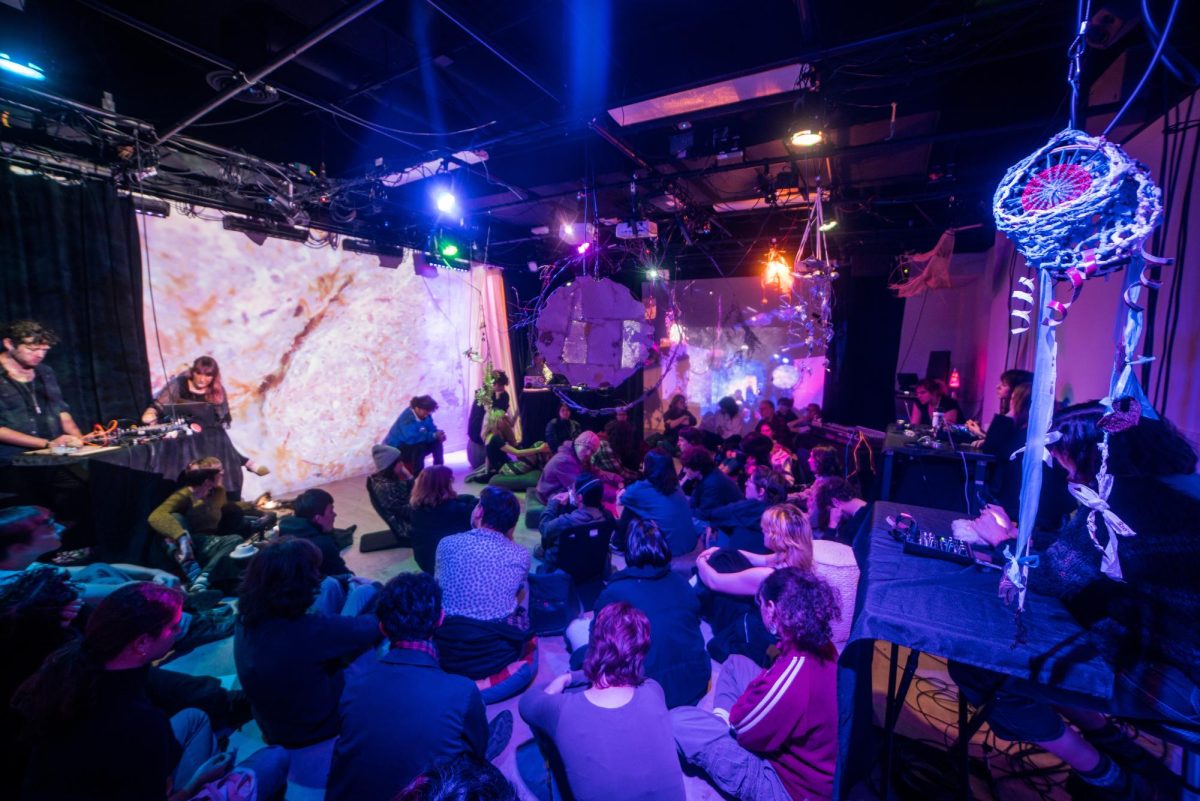In 1973, American pianist and composer David Tudor held a symposium in New Hampshire and introduced Rainforest IV. Tudor and collaborators built a variety of sonic sculptures, displaying and exploring the resonant properties of found objects. Spectators were invited to wander through the resulting jungle of sound. 50 years later, students in TIMARA Technical Director Abby Aresty’s TECH 110: Audio Harvest course recreated this project.
“Instruments, sculpturally constructed from resonant physical materials, are suspended in free space,” Tudor wrote in the original program note. “The sound materials used to program the instruments are collected from natural scientific sources and are specific to each instrument, exciting their unique resonant characteristics.”
On the night of Oct. 23, the TIMARA Performance Technology Lab transformed into an audiovisual soundscape. A purple glow illuminated dangling wires and uncanny sculptures, while projectors displayed magnified images of vivid organic materials on the walls. Around fifty students arrived to admire this installation, and the volume impeded the possibility of freely wandering through the environment as Tudor originally intended. Instead, they sat on the floor and meditated.
The theme of the night was biomaterial. Aresty gave her students freedom to explore the sounds of materials created in class and foraged objects, attempting to stay true to Tudor’s Rainforest IV while allowing space for creative reimagining. Attached to everything from bioplastics made of tea grounds to a dried gourd, loudspeakers rattled and whistled. In addition, contact microphones interpreted and combined the sound waves in order to broadcast them throughout the room.
“[The sound sculptures] are part speaker – if you walk up to them, you can hear the sound directly – but they’re also acting as an acoustic filter,” Aresty said. “So the sound that has been sent to the house is essentially filtered through the materials that people chose.”
Jesse Herdman, a third-year performer whose sound sculpture contributed to the environment through fallen branches and a paper microphone, described how the participants communicate. They followed a semblance of a score in the form of multicolored plastics adhered to a long board.
“These are microphone cameras we’re using as a cueing system,” Herdman said, gesturing to a pair of illuminated boxes wired to the plastic board. “It’s a very loose score. We’re sitting in these textures improvising off of each other and the visuals.”
As someone slowly drags a microscope camera across the bioplastics, different textures and colors appear on the walls for performers to “read.”
“So this piece is essentially a routing diagram,” Aresty said. “And then it’s left up to the composers and artists who are participating to interpret the idea. So it’s very much [David Tudor’s] piece, and yet I think the students also very much made it their own.”
Aresty described the material-driven approach established by Tudor. Rather than seek out a specific sound, she encouraged her students to begin with an object and explore the music it can produce. A metal tube rustled against the plastic tentacles of a jellyfish mobile. A composer tickled the buttons of a deconstructed toy guitar. One student blended synthesized bird sounds with the feedback produced from arduino sensors in an illuminated balloon. Another sound sculpture, coated in thermochromic paint, gradually changed color.
“What can we make these materials do, whether or not it’s what it’s supposed to do?” Aresty said. “It’s a very experimental and material-driven approach to composing with electronics. And that, to me, has been extremely influential.”
Aresty earned degrees in music composition, not electronic music production, but Tudor’s principles encouraged her to pursue diverse interests. Through her explorations, she discovered a community of people working at the intersection of textiles and sound, which has become her passion.
“I’ve taken broad courses in electronics, but it’s been a sort of self driven experimentation over the years for me and others who have been similarly influenced by David Tudor,” Aresty said. “This hands-on, experimental approach to learning electronics opens up a whole world that would otherwise feel closed off. David Tudor’s Rainforest and its material-driven approach was very much a jumping off point for me to work with electronic textiles.”
Tudor’s approach emphasizes out-of-the-box ideas. Aresty hopes this project will inspire her students to take more risks with their music-making at Oberlin and beyond in their careers.
“One of the students said, ‘Oh, I’m gonna remember this forever,’ and that is the number one thing,” Aresty said. “You graduate from school and unless you’re really active in a particular discipline, you start to lose some of the details of the classes you’ve taken. It’s not constant, not something that you’re always thinking about, but [this installation] is a memory that we’ve created together. It will stand out to them as a moment where they, as a class collectively, took a risk and brought all these people together to experiment.”





